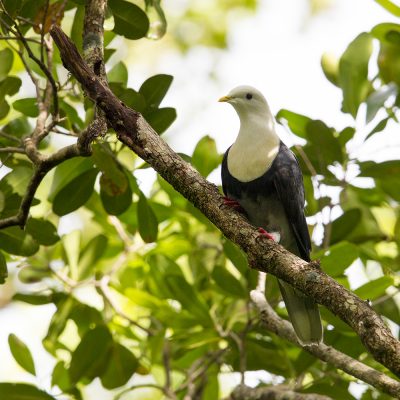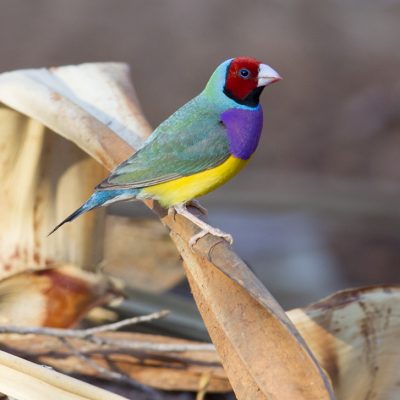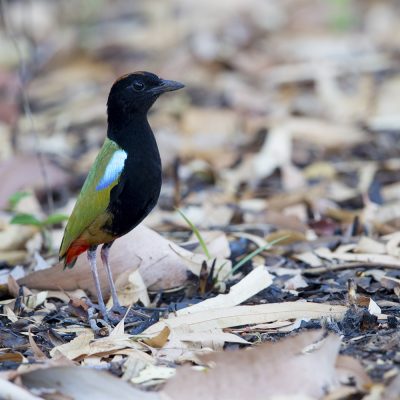GUIDE TO FINDING BIRDS AROUND CAIRNS, QLD
Cairns, in Queensland’s far north, is one of the world’s premier birding hot spots. With over 400 species to be seen within a 200 km radius of the city there are plenty of opportunities to find birds to photograph.
(Photo left to right – Blue-faced Parrot Finch, Buff-breasted Paradise Kingfisher, Golden Bowerbird, Noisy Pitta)
NORTHERN QUEENSLAND ENDEMIC BIRDS;
Tooth-billed Bowerbird, Golden Bowerbird, Victoria’s Riflebird, Sooty Owl (Lesser), Bridled & Macleay’s Honeyeaters, Grey-headed Robin, Fernwren, Atherton Scrubwren, Mountain Thornbill, Pied Monarch, Bower’s Shrike-thrush and Chowchilla.
CAIRNS WEATHER
Cairns has a Tropical climate with hot, humid summers (November – April) and mild winters (May – October). During the hot summers you have the advantage of being able to drive up to the tablelands were the temperature drops a few degrees cooler than the coast.
BEST TIME OF YEAR TO SEE BIRDS
Another fact about Far North Queensland is there’s never a bad time to visit, the summers bring some fantastic migrants like Buff-breasted Paradise Kingfisher, Dollarbird, Metallic Starlings and Spotted Whistling Ducks. Winter brings cooler temperatures making it much more comfortable to do longer walking trails.
CAIRNS CITY ESPLANADE – (Photo Above – Mangrove Robin)
Cairns has some fantastic birding really close to the city, the Cairns Esplanade can be a great place to see many wader species including Greater and Lesser Sand Plovers, Bar-tailed and Black-tailed Godwits, Great Knots, Eastern Curlews, Curlew Sandpipers, Pelicans, Intermediate Egrets, Spoonbills and maybe even a Beach-stone Curlew. Peak time of year to see waders is September to March when the migratory waders are visiting, the best time of day to see them here is usually the last two hours before high tide.
While walking along the esplanade check for flowering and fruiting trees, these attract a large number of birds like Double-eyed Fig Parrot, Rainbow Lorikeets, Metallic Starlings, Australasian Figbirds, Yellow, Brown, Lewin’s and Varied Honeyeaters and Torresian Imperial-pigeons (Summer). Other birds that can be seen in the area are Nutmeg Mannikin, White-breasted Woodswallows, Willie Wagtails and Masked Plovers.
The Northern end of the Esplanade (GPS -16.903010, 145.762759) is one of the best spots to see Mangrove Robin, you should hear them calling most of the day but early morning and evening is best. If you want great views you will need to “Psssshh, Psssshh” them out into the open, good luck and make sure you cover up as the sandflies can be friendly.
CAIRNS CITY BOTANIC GARDENS – (Photo Above – Male Olive-backed Sunbird)
Cairns Flecker Botanic Gardens located just north of the city is a beautiful place to explore, you can usually find Olive-backed Sunbirds, Yellow Oriole, Metallic Starlings and a variety of Honeyeaters.
Across the road at Centenary Lakes is another spot worth a walk around,
The Rainforest boardwalks leading to the lakes can produce Papuan Frogmouth, Orange-footed Scrubfowl, Pale-vented Bush-Hen, Nankeen Night-heron and maybe even a roosting Rufous Owl. These boardwalks are also a fantastic place to go spotlighting at night with a chance to see the stunning Striped Possum, well worth getting eaten alive by mosquito’s!
The areas around the Fresh and Saltwater Lakes are fantastic for Double-eyed Fig Parrot, Black Butcherbird, Black Bittern, Yellow, Brown-backed, Dusky, Graceful, Yellow-spotted and White-throated Honeyeaters. In the lakes themselves look for, Pacific Black Ducks, Magpie Geese, Radjah Shelducks and in the wet season months (November – March) maybe even some Spotted Whistling Ducks which are becoming a regular visitor.
Also, look out for Little Kingfisher which has been seen hanging around between the Freshwater Lake and the Mangroves (-16.902744, 145.750436).
METALLIC STARLING COLONY – (Photo above – Metallic Starling)
Metallic Starlings are a fascinating bird that migrate from Papua New Guinea to Cairns around August to breed, this spot near the airport is one of best and easily accessible making for some great photos. They stay in the Cairns area until around April, whereupon they make their return journey back to Papua New Guinea.
JACK BARNES MANGROVE BOARDWALK – (Photo Above – Male Shining Flycatcher)
This Mangrove Boardwalk near the Cairns Airport is a great place to see all of the local Mangrove specialties without having to walk through the mud. While walking the boardwalk look out for Large-billed Gerygone, Shining Flycatcher, Little and Collared Kingfisher, Striated Heron, Black Butcherbird and Mangrove Robin.
CATTANA WETLANDS – (Photo Above – White-browed Crake)
Cattana Wetlands is an up and coming wetland and is well worth a look early in the morning, there are some great walks around the freshwater lakes and can be reasonably productive.
Look for Yellow & Olive backed Oriole, Australasian Figbird, Olive-backed Sunbird, Yellow, Graceful, Yellow-spotted, Brown and Dusky Honeyeaters, Black Butcherbird, Crimson Finch, Nutmeg and Chestnut-breasted Mannikins, Little Shrike-thrush, Red-backed & Lovely Fairy-wrens, Laughing & Blue-winged Kookaburras, Forest Kingfisher.
In the lakes themselves keep an eye out for Magpie Geese, Green Pygmy Geese, Grey Teal, Pacific Black Duck, Hardhead, Australasian Grebe, Purple Swamphen, Buff-banded Rail, Pale-vented Bush-hen, Dusky Moorhen Eurasian Coot and Bush Stone-curlew.
This is also one of the better places around Cairns to see the elusive White-browed Crake especially early in the morning.
COPPERLODE DAM – (Photo Above – Black-faced Monarch)
Copperlode Dam is a great place to see Rainforest species and its 0nly a 21km drive from the city, it’s a beautiful drive with some of the best views over Cairns City.
Species seen in the area are Double-eyed Fig-Parrot, Australian King-Parrot, Wompoo Fruit-Dove, Superb Fruit-Dove, Topknot Pigeon, Rufous Fantail & Grey Fantails, Little Shrike-thrush, Bower’s Shrike-thrush, Macleay’s & Scarlet Honeyeater, Chowchilla, Eastern Whipbird, Noisy Pitta, Spotted Catbird, Tooth-billed Bowerbird, Buff-breasted Paradise Kingfisher, White-eared Monarch, Black-faced Monarch, Spectacled Monarch, Pied Monarch, Yellow-breasted Boatbill, Victoria’s Riflebird, Pale-yellow Robin and Eastern Yellow Robin.
MOSSMAN AREA – (Photo Above – Beach-stone Curlew)
Newell Beach and the Mossman River mouth -16.434256, 145.405224) is one of the best places to see Beach-stone Curlew, a pair frequent the area regularly. Also check for all the common wader species like Bar-tailed Godwit and Greater Sand Plover.
Mossman Gorge -16.472116, 145.331202 is one of the must do stops north of Cairns, Mossman Gorge is a great place to go for a swim and also to do some birding at the same time. Just be aware that the Gorge can get really busy so best to go early in the morning.
All the common Rainforest species are present here and if you have time to look it is also a great place to see the dinosaur-like Boyd’s Forest Dragon and Northern Leaf-tailed Gecko.
DAINTREE AREA – (Photo Above -Buff-breasted Paradise Kingfisher)
Daintree village is a sleepy little town 110 km North of Cairns, it’s famous for is amazing Daintree River which runs just beside the village. The best way to see birds in the Daintree is to take a boat cruise and the best man for the job is Murray Hunt, he runs DAINTREE BOATMAN NATURE TOURS. I highly recommend taking an early morning or late afternoon tour with Murray, he’s a local guide that’s very passionate about all the Fauna and Flora of the area. Murray specialises in taking out photographers, he knows how to position the boat in the right spot for that amazing photo.
Getting on the Daintree river will give you the opportunity to see Black Bittern, Great-billed Heron, Osprey, Azure & Little Kingfishers, Shining Flycatchers, Wompoo & Superb Fruit-doves, Papuan Frogmouths, Radjah Shelducks and lately they have even had some rare Spotted Whistling Ducks turn up.
Another place close to the Village is Stewart Creek Road, the whole road is very birdie especially towards the end where there is some great lowland Rainforest (-16.314590, 145.323590). Look for Pied and Spectacled Monarch, Shining Flycatcher, Black Butcherbird, Spangled Drongo and Blue-winged Kookaburra. During the months of November to March this is also a great spot to see the stunning Buff-breasted Paradise Kingfisher which migrate here from Papua New Guinea to breed in the wet season, look out for low Termite mounds near rainforest edges where they nest.
CAPE TRIBULATION – (Photo above – Azure Kingfisher)
It’s worth visiting Cape Tribulation just for the beautiful drive and ferry ride across the Daintree River, it’s also one of the best spots to see endangered Southern Cassowary. Keep an eye out on the road between the ferry and the township, they’re often seen crossing the road in this area so make sure you drive slow.
JULATTEN (KINGFISHER PARK) – (Photo Above – Noisy Pitta with Spider)
Julatten is to one of my favorite areas to visit and take photos, it has some really fantastic places to check out and if you need somewhere to stay then you can’t go past KINGFISHER PARK (-16.595104, 145.339534) which is one of Australia’s best birding lodges.
At KINGFISHER PARK they are fortunate to have a huge amount of resident birds which means you don’t have to go far to get some amazing photos. These including Noisy Pitta, Red-browed Finch, Macleay’s, Yellow-spotted and Graceful Honeyeaters, Pale-yellow Robin, Little Shrike-thrush, Yellow-breasted Boatbill, Black-faced & Spectacled Monarch, Cicadabird and Spotted Catbird. This is also the best place to see Kingfisher Park’s namesake the Buff-breasted Paradise Kingfisher which nests here between November and March in the low termite mounds on the property.
They are also famous for the Red-necked Crake which can often be seen down near the creek or Crake Pond, they also have Pale-vented Bush Hen on the property that can be found near any long grass in the area.
Spotlighting can also be very rewarding with Barking, Sooty (Lesser) and Barn Owls, Papuan Frogmouths are usually heard Calling and Boyd’s Forest Dragon and Northern Leaf-tailed Gecko are also common. Also keep an eye out for Stripped & Green Ring-tailed Possum, White-tailed Tree rat and also Long-nosed and Northern Brown Bandicoot.
They also have a resident Platypus in the stream at the bottom of the property.
MOUNT LEWIS – (Photo Above – Blue-faced Parrot Finch)
By far my favorite place to visit when I am in the area is Mount Lewis, it’s just amazing! Leaving Kingfisher Park head North for about 1.6 km, turn left onto Mount Lewis Road and from here you’ll have about 1.2km of sealed road before you hit the steep, windy gravel road. It’s about 10 km’s to the clearing where the walking trail starts, a 4WD is recommended but if you’re careful you could make it up in a SUV (Rav4 or similar).
The clearing (-16.592833, 145.275336) at the top is the best place in Australia to see the magnificent Blue-faced Parrot Finches which can be seen here during the wet season months from November to April. They’re often found hanging out with Red-browed Finches feeding on the long grass or blackberries growing in the clearing, early morning is best but can be misty due to the elevation. The clearing is also a great place to see Victoria’s Riflebird, Bower’s Shrike-thrush, Bridled, Lewin’s Honeyeaters, Mountain Thornbill, Topknot Pigeon, Brown Cuckoo-Dove, Wompoo and Superb Fruit-Doves.
MOUNT LEWIS DAM WALKING TRAIL – (Photo above – Pale-yellow Robin)
From the clearing there’s a walking trail which takes you uphill towards the top of Mount Lewis where you’ll find a small Dam. This walking trail leads you through spectacular cloud forest and is the best place to see just about all of North Queensland’s Endemic birds. Look and listen for Tooth-billed & Golden Bowerbird, Spotted Catbird, Victoria’s Riflebird, Chowchilla, Yellow-throated & Atherton Scrubwren, Grey-headed and Pale-headed Robin, Bower’s Shrike-thrush, Bridled and Lewin’s Honeyeaters, Eastern Whipbird, Rufous and Grey Fantail, Bassian Thrush, Grey and Golden Whistler and Mountain Thornbill, and Fernwren.
The damp, dark forest can make photography very difficult but that’s all part of the challenge!
The Dam itself doesn’t usually produce much but there is a resident Platypus to look out for.
WONGABEL STATE FOREST (Photo above – Male Victoria’s Riflebird)
Wongabel State Forest is definitely worth a look, there’s a loop walk and it’s one of the best places to spot Lumholtz’s Tree-kangaroos. Look for large dark objects resting in the forks of the larger trees.
It’s also a great place to see White-headed Pigeon & Brown Cuckoo-Dove, Spotted Catbird, Tooth-billed Bowerbird, White-throated Treecreeper, Large-billed and Brown Gerygone, Chowchilla, Bridled and Macleay’s Honeyeater, Yellow-breasted Boatbill, Bower’s and Little Shrike-thrush, Atherton, Yellow-throated and Large-billed Scrubwren, Pied Monarch, Pale-yellow and Grey-headed Robin.
I have also seen male Victoria’s Riflebird displaying near the track.
MOUNT HYPIPAMEE NATIONAL PARK (Photo above – Golden Bowerbird at Bower)
One of the highlights of the Atherton Tablelands is Mount Hypipamee National Park, this is one of the best places to see the magnificent male Golden Bowerbird which have Bowers in the area. It’s also a great place for Southern Cassowary which are a regular visitors to the car park, be cautious as they can be VERY dangerous.
Other birds that can be found in the general area are Eastern Spinebill, Grey-headed and Pale-yellow Robin, Lewin’s and Bridled Honeyeater, Chowchilla, Spotted Catbird and also Tooth-billed Bowerbirds.
Mount Hypipamee is also the great for spotlighting as I’ve seen Green, Herbert River, Lemuroid Ringtail and Brushtail Possum all in one night up here. Lumholtz Tree Kangaroo can also be seen here along with the rare Long-tailed Pygmy Possum if you’re lucky.
CURTAIN FIG TREE, YUNGABURRA
Close to Yungaburra, the Curtain Fig Tree is a very impressive sight and well worth a look. Along with the spectacular Fig Tree this area is also great for Pied, Black-faced and Spectacled Monarch, Yellow-breasted Boatbill, Pale-yellow and Grey-headed Robin, Victoria’s Riflebird, Little and Bower’s Shrike-thrush, Spotted Catbird, Lewin’s and Macleay’s Honeyeaters.
If you haven’t seen a Platypus yet then try the Yungaburra viewing platform just south west of town off the Gillies Highway, GPS -17.274643, 145.580970
CRATER LAKES NATIONAL PARK, LAKE BARRINE & EACHAM – (Photo above – Boyd’s Forest Dragon)
Lake Eacham – GPS -17.284738, 145.629374
Lake Barrine – GPS -17.245215, 145.639140
Lake Eacham and Lake Barrine hold a special place in my heart. Lake Eacham was where I proposed to my lovely wife Lauren, it has always been one of our favorite places to visit on a Sunday and have a BBQ and swim.
Saying all of this both Lakes are also fantastic places to go for a walk around and photograph some great birds.
These include Tooth-billed Bowerbird, Spotted Catbird, Victoria’s Riflebird, Double-eyed Fig-Parrot, Australian King Parrot, White-throated Treecreeper, Yellow-throated Scrubwren, Eastern Spinebill, Lewin’s Honeyeater, Bridled honeyeater, Dusky Honeyeater, Scarlet Honeyeater, Brown Honeyeater, Macleay’s Honeyeater, Chowchilla, Eastern Whipbird, Black-faced Cuckoo-shrike, White-bellied Cuckoo-shrike, Barred Cuckoo-shrike, Pale-yellow Robin, Grey-headed Robin, Black-faced Monarch, Spectacled Monarch and Grey Fantail.
Also look for the very sneaky Boyd’s Forest Dragon which are common at both lakes, they are usually found on a smallish vertical branch about one metre off the ground and will be looking right at you!




















